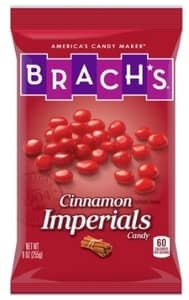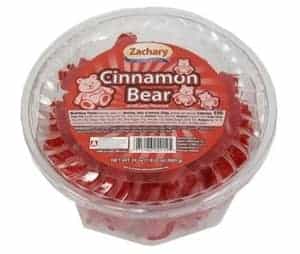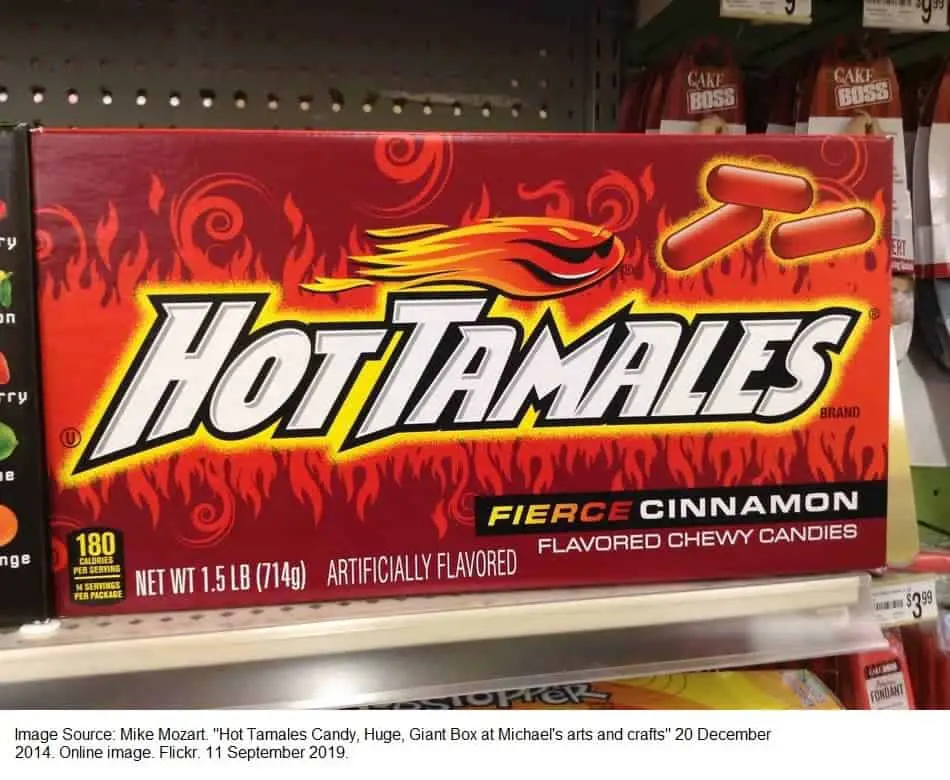Hot Tamales is a popular brand of chewy candy. Like Mike and Ike, it’s shiny and oblong-shaped candy, but it’s cinnamon-flavored (rather than fruity), and a bit on the spicy side as the name implies.
So, here we’re talking about the candy which is not to be confused with often spicy Tamales in Mexican Cuisine—the food product the candy derives its name from.2 Perhaps I’ll do an article on those another time.
Are they vegan? Hot Tamales are considered by some in the community to be suitable for vegans. Others in the community consider the candy to be off-limits. The controversy has to do with the presence of confectioner’s glaze which contains shellac—a resin secreted by lac bugs.
The candy also contains carnauba wax, an ingredient that’s considered 100% vegan-friendly by any standards. Carnauba wax, aka Brazil wax or palm wax, derives from the leaves of the palm Copernicia prunifera—a plant native to northeastern Brazil.2
Perhaps one day they’ll transition to using only carnauba and other plant-based waxes.
Anyway, Hot Tamales are very popular and were the top-selling cinnamon candy as of the late 90s.3
For this reason, a lot of vegans grew up enjoying the candy and want to know if they have to give it up after switching to a 100% animal-free diet.
So, what we’ll do is get into the various factors you should consider when determining if Hot Tamales are “vegan enough” for you.
Why Some Consider Hot Tamales to Be Non-Vegan
Hot Tamales Contain Confectioner’s Glaze
Per the ingredients label, Hot Tamales contain:4
- Sugar, corn syrup, and modified food starch
- Pear juice concentrate
- Citric, malic, and fumaric acids
- Sodium citrate and magnesium hydroxide
- Pectin (a natural plant fiber)
- Waxes including confectioner’s glaze and carnauba
- White mineral oil
- Artificial colors—Red 3, Red 40, Yellows 5 and 6, Blues 1 and 2.
Confectioner’s glaze derives from a substance that lac bugs leave behind when traversing tree branches.5
It’s mostly composed of tree sap. The little critters suck up the sap and secrete a substance called sticklac which contains another substance known as shellac.
The shellac is filtered out by food manufacturers to be used in various products.
The bugs use this substance to make mini-structures that resemble cocoons, though they’re not considered cocoons in the entomological sense.6
Many vegans view the ingredients as off-limits, while less strict vegans tend not to scrutinize such ingredients too heavily.
I personally tend to fall into the former camp, due to the cultivation process that uses bugs to produce the substance
It’s estimated to take around 50,000 to 300,000 bugs to produce just one kg (or 2.2 lb) of shellac.7-9
It seems impossible that many bugs wouldn’t be killed in the process of harvesting the sticklac. When the substance is scraped from branches, it has to be filtered in order to remove all of the bark and dead bugs.
Sure, the bugs could’ve already been dead, but it seems highly doubtful.
But, the ingredient remains a grey area, insofar as the use of insect-derived products remains a matter of contention in the community.
It’s true that the American Vegan Society does NOT give the green light on silk, honey, and other insect-derived substances.10,11
Nevertheless, vegan groups continue to disagree about insect products.12
Some believe that exploiting the labor and resources of insects to be immoral, citing the harm that commercial beekeeping operations cause to bees.13
I would imagine the same types of arguments surrounding honey production, on both sides of the debate, would apply equally to the issue of confectioner’s glaze.
Ultimately, it’s a personal choice. I’m just here to present the information.
Why Hot Tamales Are Considered by Some to Be Vegan
For those who are not bothered by the presence of confectioner’s glaze, the candy ticks all of the other vegan-friendly boxes, in that it doesn’t contain the most common non-vegan ingredients used in candy making
Hot Tamales Don’t Contain Egg Albumin
Albumin (spelled with an “i”) is the protein content of eggs—namely, the protein that surrounds egg yolk.14
Albumen (with an “e”) is the water/protein mixture that composes egg white. Albumen is largely made of protein (albumin) and water and accounts for about 58% of an egg’s weight.
A lot of chewy candies make heavy use of aerators, and albumin is one of the most common.15 Other proteins, such as soy, can also be used but are much less common in candy making.16
Anyway, Hot Tamales don’t contain any, so that’s good news.
Hot Tamales Don’t Contain Gelatin
Gelatin is the translucent, colorless, flavorless, food ingredient derived from collagen—the protein found abundantly in certain body parts (the epidermis of the skin, etc.).
It’s another common aerator in candy making and is a favorite for use in chewy candy.
It is always non-vegan because commercially, gelatin tends to be made from by-products of animal agriculture (i.e. the meat and leather industries).
It’s usually produced from pork skins, split cattle hides, and the bones of cattle and pork.17
Fortunately for Hot Tamales lovers, it’s not used in this product.
Hot Tamales Contain Red 3 and Red 40
Red 3 (Erythrosine) and Red 40 (Allura Red) are “azo” dyes meaning that they’re derived from coal tar. The food colorings are common in soft drinks, candies, popsicles, and children’s’ medicine.
The two are often mistaken for Red 4, another common red pigment, but one that’s produced from beetles.18
Red 4 aka carmine derives from carminic acid—it’s actually the carminic acid that comes from beetles.19
Tons of beetles need to be killed to generate small quantities of the stuff. Not only is it derived from insects, but certain methods used to produce it often involve other animal products like egg white, gelatin, and fish glue.20
Kinda like with confectioner’s glaze and other insect-derived substances, I’d imagine that some vegans wouldn’t shy away from it, but it’s at least one more ingredient we needn’t worry about.
Hot Tamales Alternatives (No Confectioner’s Glaze)
These are not by any means the same. But, they don’t contain any grey area ingredients.
Brach’s Cinnamon Imperials Candy

These are harder than Hot Tamales, but they don’t contain any questionable ingredients. In fact, they only contain corn syrup, sugar, natural and artificial Flavors, and a few dyes (Red 40, Red 3, Blue 1, Yellow 6).21
Zachary Cinnamon Bears Candy

This candy is chewy and contains carnauba as the only wax. Other ingredients include corn syrup and sugar, modified food starch, natural and artificial flavors, mineral oil, and Red 40.22
That’s it for the vegan status of Hot Tamales. Thanks for reading.
You may also want to check out the following related articles:
References
- Hot Tamales. https://en.wikipedia.org/wiki/Hot_Tamales
- Steinle, J. Vernon (September 1936). “Carnauba wax: an expedition to its source”. Industrial & Engineering Chemistry. 28 (9): 1004–1008.
- Company Is Making More Than a Peep in the Candy Industry. https://www.latimes.com/archives/la-xpm-1999-oct-11-fi-21120-story.html
- Hot Tamales, Fierce Cinnamon Chewy Candy, 4.5 Lb. Jacob- Joel – https://www.walmart.com/ip/Hot-Tamales-Fierce-Cinnamon-Chewy-Candy-4-5-Lb/51893631
- Flinn, Angel. “Shellac and Food Glaze” http://gentleworld.org/shellac-food-glaze/
- Shellac, WoodworkDetails.com: Shellac as a Woodworking Finish. http://www.woodworkdetails.com/knowledge/finishing/shellac
- Bangali Baboo; D. N. Goswami (2010). Processing, Chemistry and Application of Lac. New Delhi, India: Chandu Press. p. 4.
- Yacoubou, Jeanne (30 November 2010). “Q & A on Shellac”. Vegetarian Resource Group. http://www.vrg.org/blog/2010/11/30/q-a-on-shellac/
- Velji, Vijay (2010). “Shellac Origins and Manufacture”. shellacfinishes.com. https://www.youtube.com/watch?v=lQcQ0yuekZ0&t=5m23s
- The Honey Industry. https://www.vegansociety.com/go-vegan/honey-industry
- Fanny Kemble, Journal of a Residence on a Georgian Plantation in 1838–1839, Harper and Brothers, New York, 1863, 197–198
- Why Vegans Can’t Decide Whether They’re Allowed To Eat Honey. Daniel Engber – https://www.slate.com/articles/life/food/2008/07/the_great_vegan_honey_debate.html
- Hart 1995, 14; Francis, Fruitlands: The Alcott Family and their Search for Utopia, 2010. https://books.google.com/books?id=hvmfshZxPf0C&pg=PA14#v=onepage&q&f=false
- Understanding Food: Principles and Preparation (Page 250). Amy Brown – Wadsworth Cengage Learning – 2011
- Chocolates and Confections: Formula, Theory, and Technique For the Artisan Confectioner (Page 356). Peter Greweling-Ben Fink – John Wiley & Sons – 2013
- Chocolates and Confections: Formula, Theory, and Technique For the Artisan Confectioner (Page 363). Peter Greweling-Ben Fink – John Wiley & Sons – 2013
- “Natural Health Products Ingredients Database: Hydrolyzed Collagen”. Government of Canada, Health Canada, Health Products and Food Branch, Natural Health Products Directorate. 12 June 2013.
- Bug-Based Food Dye Should Be Exterminated, Says CSPI. https://cspinet.org/news/bug-based-food-dye-should-be-exterminated-says-cspi-20060501
- Carminic Acid https://en.wikipedia.org/wiki/Carminic_acid
- Carmine https://en.wikipedia.org/wiki/Carmine#Production
- Brach’s, Cinnamon Imperials Hard Candy, 9 Oz https://www.walmart.com/ip/Brach-s-Cinnamon-Imperials-Hard-Candy-9-Oz/55434593
- Zachary, Cinnamon Bears Candy, 24 Oz. Trena – https://www.walmart.com/ip/Zachary-Cinnamon-Bears-Candy-24-Oz/28131357


